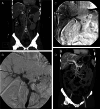The value of primary vascular stents in management of early portal vein stenosis after liver transplantation
- PMID: 27106002
- PMCID: PMC11916546
- DOI: 10.1016/j.kjms.2016.02.003
The value of primary vascular stents in management of early portal vein stenosis after liver transplantation
Abstract
If portal vein stenosis (PVS) occurs within 1 month after liver transplantation (LT), especially within 1 week, it can be catastrophic and result in rapid loss of the grafts and mortality. Although surgical treatments have been considered standard treatment for PVS, patients are usually unable to receive operations or re-transplantations, because of their critical conditions and a shortage of grafts. Recently, primary percutaneous transhepatic portal vein stents (PTPS) were suggested as alternative and less-invasive treatments of PVS. However, because lethal complications may follow these primary stent placements for patients in early stages after LT, primary PTPS placements for patients suffering PVS 1 month after LT has been suggested. From November 2009 to July 2015, 38 consecutive adult patients underwent LT at our institution. Among them, six recipients suffered PVS within 1 month after LT. Technical success was achieved in all six patients. Clinical success was obtained in two of the four patients suffering PVS within 1 week after LT, and in the other two patients suffering PVS>1 week after LT. All surviving patients and their grafts were in good condition, and their stents remained patent. Our experience showed that primary PTPS placements can be used to effectively treat patients with PVS encountered within 1 month, and even within 1 week, after LT with acceptable short-term results. However, possible fatal complications should be kept in mind. Long-term results of these procedures need further follow-up.
Keywords: Doppler ultrasound; Liver transplantation; Percutaneous transhepatic portal vein stent; Portal vein stenosis; Portography.
Copyright © 2016. Published by Elsevier Taiwan.
Figures

References
-
- Settmacher U., Nussler N.C., Glanemann M., Haase R., Heise M., Bechstein W.O., et al. Venous complications after orthotopic liver transplantation. Clinical Transplant. 2000; 14: 235–241. - PubMed
-
- Woo D.H., Laberge J.M., Gordon R.L., Wilson M.W., Kerlan R.K. Jr.. Management of portal venous complications after liver transplantation. Tech Vasc Interv Radiol. 2007; 10: 233–239. - PubMed
-
- Baccarani U., Gasparini D., Risaliti A., Vianello V., Adani G.L., Sainz M., et al. Percutaneous mechanical fragmentation and stent placement for the treatment of early posttransplantation portal vein thrombosis. Transplantation. 2001; 72: 1572–1582. - PubMed
-
- Kim Y.J., Ko G.Y., Yoon H.K., Shin J.H., Ko H.K., Sung K.B.. Intraoperative stent placement in the portal vein during or after liver transplantation. Liver Transpl. 2007; 13: 1145–1152. - PubMed
MeSH terms
LinkOut - more resources
Full Text Sources
Other Literature Sources
Medical
Research Materials

